Testimony by Stephen C. Goss,
Chief Actuary for Social Security Administration
House Ways and Means Subcommittee on Social Security
June 7, 2018
Chairman Johnson, Ranking Member Larson, and members of the subcommittee, thank you very much for the opportunity to speak to you today about the 2018 Social Security Trustees Report. This report has been produced and submitted to the Congress every year starting in 1941, the year after monthly benefits were first paid from a Social Security trust fund.
By law, the Trustees are required to report annually on the financial operations of the trust funds for the immediate past year, the projected operations of the trust funds over the next 5 years, and the actuarial status of the trust funds.
2018 Report
For the 2018 Trustees Report, we have three main changes from a year ago.
- First, based primarily on continuing lower-than-expected disability application and incidence rates through 2017, the projected reserve depletion date for the DI Trust Fund is extended once again, by an additional 4 years, from 2028 in last year’s report to 2032 in this report. The DI reserve depletion date is extended in spite of the fact that disability incidence is assumed to rise more rapidly to the same ultimate rate as in last year’s report.
- Second, the projected reserve depletion date for the OASI Trust Fund is projected to be late in 2034, a few months earlier than the date early in 2035 projected in last year’s report. This change results largely from lower projected revenue to the OASI, DI, and HI Trust Funds in the near term, due to lower-than-expected earnings as a share of GDP for 2016 and 2017, and assuming that a greater share of the low productivity growth over the last decade will be a permanent loss resulting in less economic growth over the remainder of the economic recovery.
- Third, the actuarial status over the long range (75-year) period is similar to last year, with the OASDI actuarial deficit increasing less than expected and annual deficits in later years lower than expected in last year’s report, due largely to higher projected death rates, recent legislation, and improvements in projection methods.
During calendar year 2017, the Old-Age and Survivors Insurance (OASI) Trust Fund reserves increased by $19 billion, nearly $14 billion less than projected in last year’s report, due to lower-than-expected payroll tax revenue. The Disability Insurance (DI) Trust Fund reserves increased by $25 billion, about $1 billion less than projected in last year’s report, because program cost was $2 billion less than expected while payroll tax revenue was $3 billion less than expected. At the beginning of 2018, the combined OASI and DI Trust Fund reserves were over $2.89 trillion, about three times the annual cost of the program.
Over the next 5 years, the combined reserves are projected to decline, reaching $2.79 trillion at the beginning of 2023, or just over two times annual program cost. The increase in combined reserves projected in last year’s report between 2018 and 2022 is reversed this year largely due to the lowered payroll tax and other revenue in this year’s report. The decline continues after 2022 as the baby-boom generations continue to move into retirement ages and are replaced at working ages by the lower-birth-rate generations born after 1965. The OASI and DI Trust Funds, individually and combined, are projected to be fully solvent through the next 10 years, thanks, in part, to the payroll tax rate reallocation included in Bipartisan Budget Act of 2015. At the time of enactment, we estimated that the date of trust fund reserve depletion for DI would be extended 6 years from 2016 to 2022. In the 2016 Trustees Report, we projected that DI reserves would not deplete until 2023, largely due to the lower-than-expected recent level of benefit expenditures. The projected reserve depletion date was further extended to 2028 for the 2017 Trustees Report, based on continued sharp declines in applications and incidence rates. For this year’s report, we are projecting an additional 4-year extension of the DI reserve depletion date, to 2032. Applications for disability benefits have been declining steadily since 2010, and have continued to be below our prior projections. The total number of beneficiaries paid from the DI Trust Fund has now been falling since 2013. The projected reserve depletion date for the DI Trust Fund is now almost as far away as for the OASI Trust Fund. With further declines in disability applications since assumptions were established for the current Trustees Report, it is likely that next year’s Trustees Report will further extend the date for DI reserve depletion.
Actuarial status of the trust funds is in part assessed on the basis of the projected ability of the trust funds to pay benefits scheduled in the law in full and on time. Under the law, all income is invested in trust fund reserves on a daily basis, and benefit obligations and administrative costs are paid on the basis of redeeming bonds held by the trust funds as needed. The law provides no ability for the trust funds to borrow or receive revenue from sources other than specified taxes and interest on the reserves. Thus, should reserves become depleted with continuing tax revenue less than needed to meet current obligations, benefits scheduled in the law would not be payable in full on a timely basis.
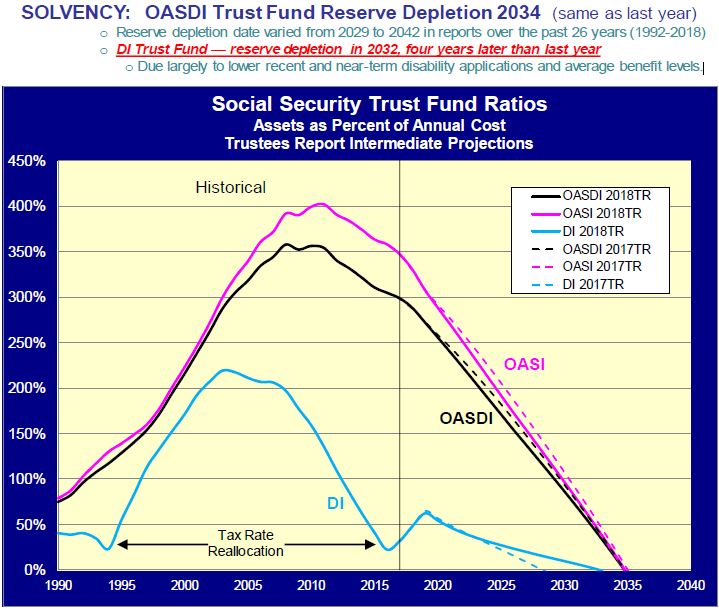
Fortunately, in the entire 82-year history of the program, the Congress has always made timely adjustments in the law to avoid reserve depletion and any sudden reduction in benefits paid. The real purpose of our reporting on the actuarial status of the trust funds is to illustrate to the Congress any expected shortfall in financing of scheduled benefits so that further adjustments to the law can be made on a timely basis.
Under the intermediate assumptions used for the 2018 report, we project that the combined reserves will be depleted in 2034, the same year as in the last report, with continuing income under current law equal to 79 percent of program cost at the time of depletion (increased from 77 percent in last year’s report). By the end of the 75-year projection period, income under current law is projected to equal 74 percent of the cost of the program, slightly more than the projected 73 percent payable in last year’s report. The projected revenue for the OASDI program for 2092 is now projected to fall short of scheduled revenue by 4.32 percent of taxable payroll, somewhat less than the 4.52 percent shortfall projected for 2092 last year.
In essence, this means that by 2034 we will need adjustments in the law so that (1) the scheduled revenue for the OASDI program will be increased by about one-third (29 percent), (2) scheduled benefits will be reduced by about one-fourth (23 percent), or (3) some combination of these adjustments is enacted. Enacting changes well before reserve depletion, even if with delayed effective dates, will allow more options to be considered, more advance warning for those affected, and a more gradual phase-in of adjustments. Over the past 26 years, Trustees Reports have projected reserve depletion as early as 2029 and as late as 2042.
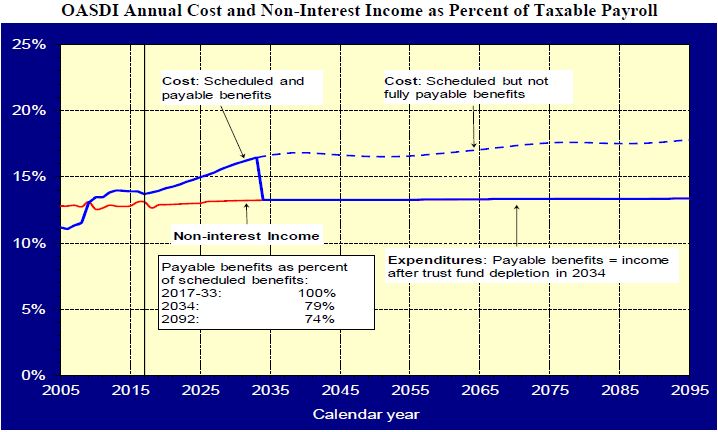
Considered alone, the separate DI Trust Fund may require some adjustment before 2034. Even with the changes in the BBA 2015 and the financially favorable recent experience, DI reserves are projected to become depleted in 2032, at which time continuing income would be equal to 96 percent of scheduled cost (up from 93 percent projected last year). By the end of the 75-year period, scheduled income is projected to be sufficient to cover 83 percent of scheduled cost (up from 82 percent projected last year).
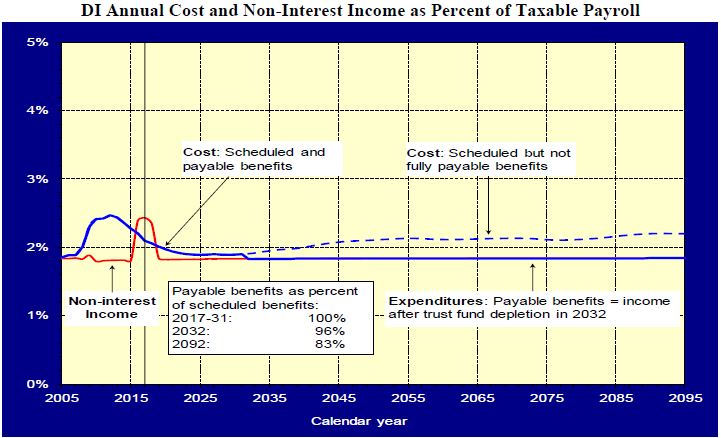
The 4-year extension of the reserve depletion date for the DI Trust Fund in this year’s report reflects:
a) Another year, 2017, with disability applications and incidence rates well below our expectations. The number of applications for 2017, when the economy had not yet risen to the sustainable full employment level, was below the annual level at the peak of the last economic cycle (2007),
b) Lower overall average benefit levels for newly awarded disabled workers in 2017 and thereafter than expected last year, because of an increased proportion of awards by Administrative Law Judges (ALJs), where average benefit levels tend to be lower,
c) Partially offsetting effects from a faster path back up to the ultimate assumed disability incidence rates, increased awards by ALJs from efforts to more rapidly reduce the backlog, and the reduced near-term revenue noted earlier.
The next figure shows the continued decline in Social Security disability applications received at the state Disability Determination Services through 2017, falling well short of expectations for several years now.
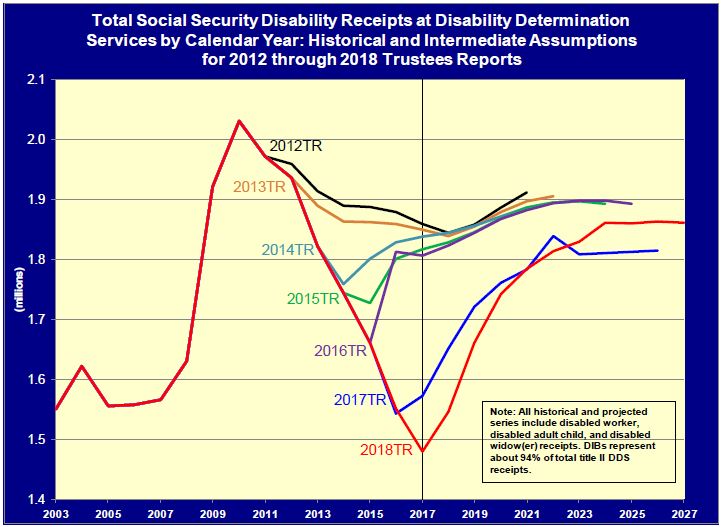
Given the degree of decline in applications through 2017 in an economy that is still short of full recovery even to the sustainable full employment level, we are now projecting that applications will rise more rapidly than in recent past reports in order to reach the assumed ultimate disability incidence rate by 2027, several years sooner than in last year’s report. As noted earlier, however, applications have continued to decline in 2018.
The next figure shows the assumed rise to the ultimate incidence rate assumed for this year’s report compared to the assumptions for the last several reports.
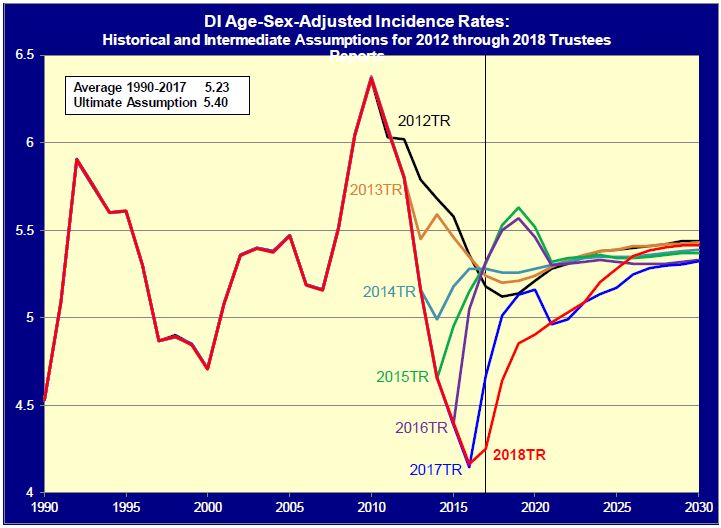
For the last several reports, we have assumed that the age-sex-adjusted disability incidence rate would rise quickly back to the expected ultimate rate of 5.4 per thousand insured workers exposed to the risk of becoming disabled. For this year’s report, the assumed incidence rate again rises rapidly, exceeding last year’s rate by 2023, and reaches the ultimate assumed level in 2027, several years earlier than in last year’s report. The temporary elevated levels of incidence rates in years 2017 through about 2020 in recent reports reflects the expectation that the backlog of disability cases awaiting a determination from an ALJ will be eliminated in the next 3 to 4 years.
Expressed as a percent of the total Gross Domestic Product (GDP) of the United States, the scheduled cost of the OASDI program is projected to rise from 4.9 percent in 2018 to about 6 percent for 2035 and later. Projected scheduled revenue is lower over this period, between 4.6 and 4.8 percent of GDP. The fact that scheduled annual non-interest income, largely the 12.4 percent payroll taxes paid by employees and employers, is no longer sufficient to cover annual program cost is primarily due to the changing age distribution of the adult population. The fact that projected OASDI cost as a percent of GDP is basically stable after 2035 speaks to the sustainability of the program’s benefit and revenue structure. The changing age distribution will simply require adjustments in scheduled income and/or cost.
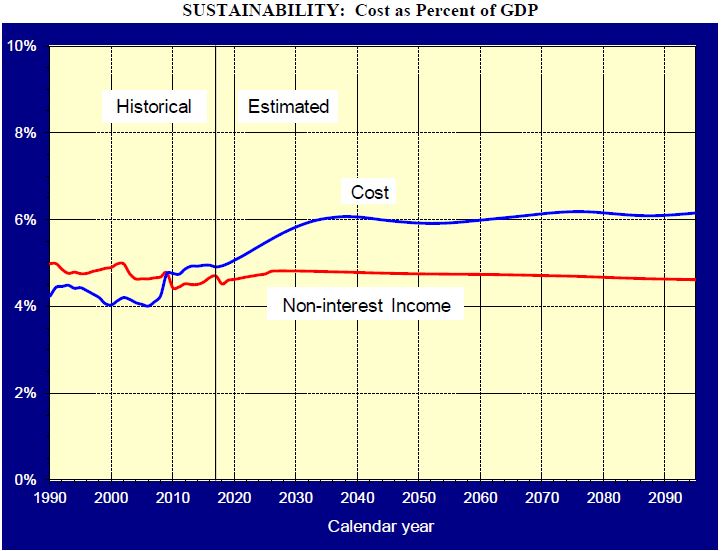
The cost as percent of GDP closely follows the ratio of beneficiaries to covered workers, because the average benefit under the program is designed to rise at about the same rate as average earnings.
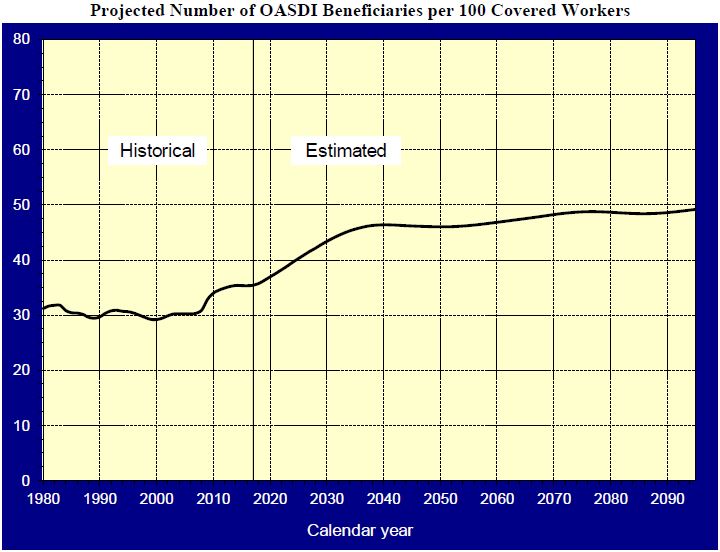
The ratio of beneficiaries to covered workers in turn follows closely the “aged dependency ratio” (population age 65 and over as a percent of the working age population age 20 through 64). The next figure illustrates that the large increase in this ratio between 2010 and 2035 is due primarily to the drop in birth rates from about 3 children per woman historically (3.3 during the baby-boom years) to about 2 children per woman in recent years.
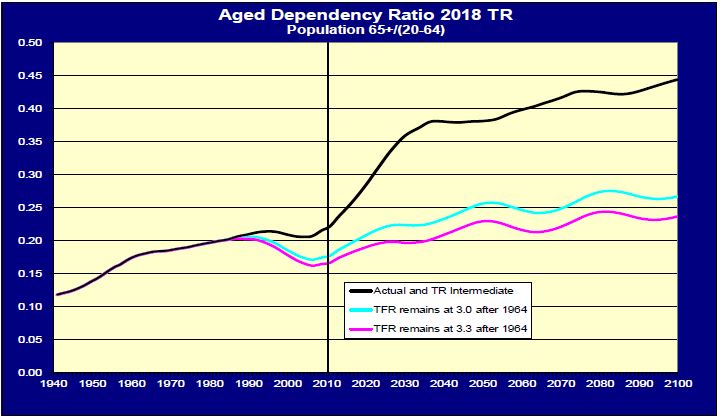
Changes in longevity through declines in death rates play a more gradual but steady role in the trend of the aged-dependency ratio. Changes in death rates over age 65 are important for the actuarial status of the OASDI program. Fortunately, mortality projections used in the Trustees Reports have provided a sound basis for evaluating the actuarial status of the program in the past. While some have suggested assuming dramatically faster mortality improvement, the track record for the Trustees Reports, plus the very substantial deceleration in mortality improvement since 2009, suggest that projections in the 2018 report represent a sound basis for evaluating prospects for the future.
Summary Measures of Actuarial Status
The Trustees Report uses several summary measures and tests to indicate the actuarial status of the trust funds from different perspectives. The actuarial deficit for the OASDI program as a whole increased from a 75-year shortfall of 2.83 percent of taxable payroll in last year’s report to 2.84 percent of payroll in this report, a much smaller increase than had been expected a year ago. The actuarial deficit is the excess of the cost for full scheduled benefits over the next 75 years, including the cost of having a reserve at the end of the period equal to 100 percent of annual cost, over the scheduled income for the program over the next 75 years, including the starting trust fund reserve level, all expressed as a percent of payroll.
Overall, changes in legislation, assumptions, recent experience, and methods had a positive effect on the actuarial balance, and thus on the actuarial status of the OASDI program. The small net negative effect on the actuarial balance was only due to the effect of changing the valuation period for the new report. The following table highlights the main factors in the change in the actuarial balance for this year.
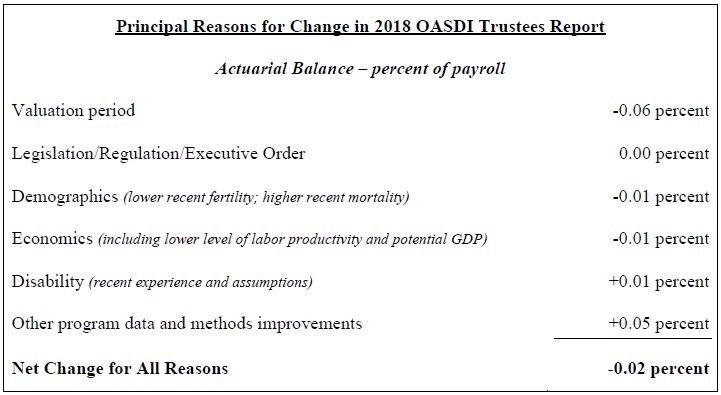
The change in the valuation period, effectively adding a year to the end of last year’s 75-year period, reduces the actuarial balance because of the relatively large annual deficits at the end of the period.
For this report, we assumed that the Deferred Action for Childhood Arrivals (DACA) program would be phased out over the next two years based on the Department of Homeland Security’s September 2017 rescission of the 2012 DACA policy. The net effect of this change, and the net effect of new legislation since the last report, on the OASDI actuarial balance are both negligible.
Lower recent experience and near-term expectations for birth rates contribute toward a reduction (worsening) in the actuarial balance. Continued higher-than-expected death rates nearly offset the effect of birth rates on the actuarial balance. During the recent recession and partial recovery, productivity (economic output per hour worked) has not increased as fast as previously expected. For the 2018 report, we have accepted that a portion of this loss in labor productivity will be permanent, resulting in less economic growth in the near term and a reduction in the actuarial balance. Lower-than-expected disability application and incidence rates increased (improved) the actuarial balance. Finally, several changes were made in projection methods and recent program experience that had a positive net effect on the actuarial balance.
Another long-range summary measure is the open group unfunded obligation of the program. This is the excess of projected program cost in the next 75 years over the projected revenue in the next 75 years (plus starting reserves). For the 2018 report, the open group unfunded obligation increased slightly in present value dollars and as a percent of GDP over the 75-year period, primarily due to the change in the valuation date.

The Trustees apply a short-range test of financial adequacy that requires that reserves remain at or grow to at least 100 percent of annual cost over the next 10 years. The OASI Trust Fund and the combined OASI and DI Trust Funds again satisfy this test. The DI Trust Fund once again does not.
Section 709 of the Social Security Act also requires that the Trustees report to Congress when a Trust Fund is projected to have reserves below 20 percent of annual cost in the future. In order to give Congress ample time to consider necessary adjustments, the Trustees make such reports when the reserve ratio is projected to be below 20 percent within the next 10 years. Again this year, the Trustees have submitted this notice to the Congress for the DI Trust Fund. The DI Trust Fund reserve ratio was 48 percent at the beginning of this year and will rise to 62 percent at the beginning of 2019, due in part to the tax rate reallocation enacted in 2015. The ratio will then decline and will fall below 20 percent by the beginning of 2027, and without Congressional action, reserves will become depleted in 2032.
The Trustees also report on the long-range test for close actuarial balance. This test requires that the program satisfy the short-range test of financial adequacy and, in addition, maintain a positive reserve throughout the remainder of the 75-year projection period, indicating the ability to pay all scheduled benefits in full on a timely basis. At this time, neither the OASI nor DI Trust Funds individually or combined meet this long-range test. While the financial and benefit structure of the OASDI program is sound, adjustments are needed to accommodate the changing age distribution of the population over the next 20 years that is largely the result of persistent lower birth rates after 1965.
Actuarial Opinion
The Social Security Act requires a statement of actuarial opinion from the Chief Actuary of the Social Security Administration regarding the reasonableness of assumptions and methods used in the report. I am happy to indicate that the actuarial opinion for the OASDI Trustees Report has never included a qualification of the assumptions and methods used to project the actual cost and operations of the trust funds under current law.
However, starting with the 2014 report, the actuarial opinion has included a caveat regarding a reference in the OASDI report to an appendix on federal budget accounting in the Medicare report. This appendix, first introduced in 2004, describes the implications of projected OASDI and Medicare Trust Fund operations under the customary budget scoring convention. This caveat warns the reader that discussion of the trust funds in relation to the overall federal budget and implications for federal debt held by the public are distorted and misleading because of use of this budget scoring convention. This convention presumes that OASDI obligations scheduled in the law that cannot be paid in full and on time after trust fund reserve depletion, will nonetheless be paid at the expense of the General Fund of the Treasury. The General Fund is presumed to borrow from the public as needed to pay full scheduled benefits after reserve depletion. The problems with this convention are: (1) the law does not permit such general fund transfers, either before or after trust fund reserve depletion; (2) there has never been a precedent for a change in the law providing such transfers; and (3) results presented in the budget scoring context do not provide clear disclosure that they are hypothetical projections presuming a change in law that would allow for the indicated general revenue transfers to the trust funds after reserve depletion.
Please note that the 2018 and all prior years’ Trustees Reports are available at https://www.ssa.gov/oact/pubs.html, along with a wide variety of additional actuarial analyses related to the reports and to changes policymakers have considered for making adjustments to the program.
Conclusion
Based on the experience of the past year and the intermediate assumptions of the 2018 Trustees Report, there are three main points I would like to make.
- First, the date of DI Trust Fund reserve depletion has been extended 4 years to 2032.
- Second, the reserve depletion date for OASI Trust Fund is projected for late in 2034 rather than early in 2035 from last year’s report due to several factors that lower payroll tax revenue for OASI, DI, and HI, in the near term.
- Third, the actuarial status of the combined OASI and DI Trust Funds is similar to a year ago, with the long-range actuarial deficit rising from 2.83 percent of payroll to 2.84 percent, rather than to the level of 2.88 percent of payroll expected from changing the valuation period alone. In addition, the program’s annual deficit toward the latter end of the projection period is significantly reduced.
The long-known and understood shift in the age distribution of the United States population will continue to increase the aged dependency ratio, and in turn increase the cost of the OASDI program as a percentage of taxable payroll and GDP. Once this shift, reflecting the drop in the birth rate after 1965, is complete around 2035, the cost of the program will be relatively stable at around 6 percent of GDP. We look forward to working with this Committee and others in developing the adjustments to the law that will be needed to keep the program in good financial order, providing retirement, disability, and survivor benefits for future generations.
Again, thank you for the opportunity to talk about the 2018 Trustees Report. I will be happy to answer any questions you may have.